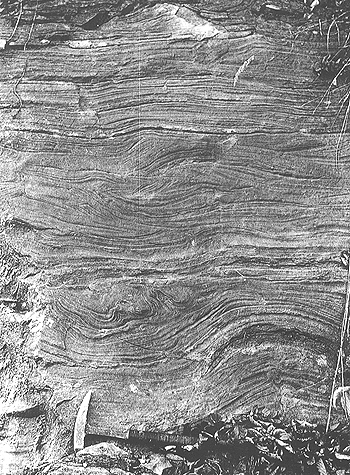
Convolute and oversteepened foreset laminae
Plate 118

Convolute and oversteepened foreset laminae
Plate 118
In this wholly laminated bed of fine sandstone, different types of lamination are superposed: parallel laminae, cross-laminae, and convoluted laminae. As an exercise in fine stratigraphy, you can try to delimit the various intervals by overlapping a transparent sheet.
Convolute laminae show a "disharmonic" curvature, with different radii, and a leftward vergence. In the central cross-laminated portion of the bed, you will note that some foresets are steeper than the angle of repose (which usually does not exceed 20-25° in these materials). The dip of both convolute and foreset laminae are consistent in indicating a paleocurrent flowing from right to left. The shear, or drag force imparted by the current to the newly deposited (and, in part, still accumulating) sediment, was the mechanism responsible for the deformations. Remarkable is the fact that rippled sediment reacts with a mass behavior, when we know that free movement of individual sand grains is required to form ripples. Clearly, the sand acquired some cohesion soon after deposition and "froze" the cross laminae. The presence of some matrix can explain this phenomenon (remember that ripples in turbidites, crevasse deposits, etc. are not purely tractive but tractive-fallout structures).
Marnoso-arenacea Formation, northern Apennines.